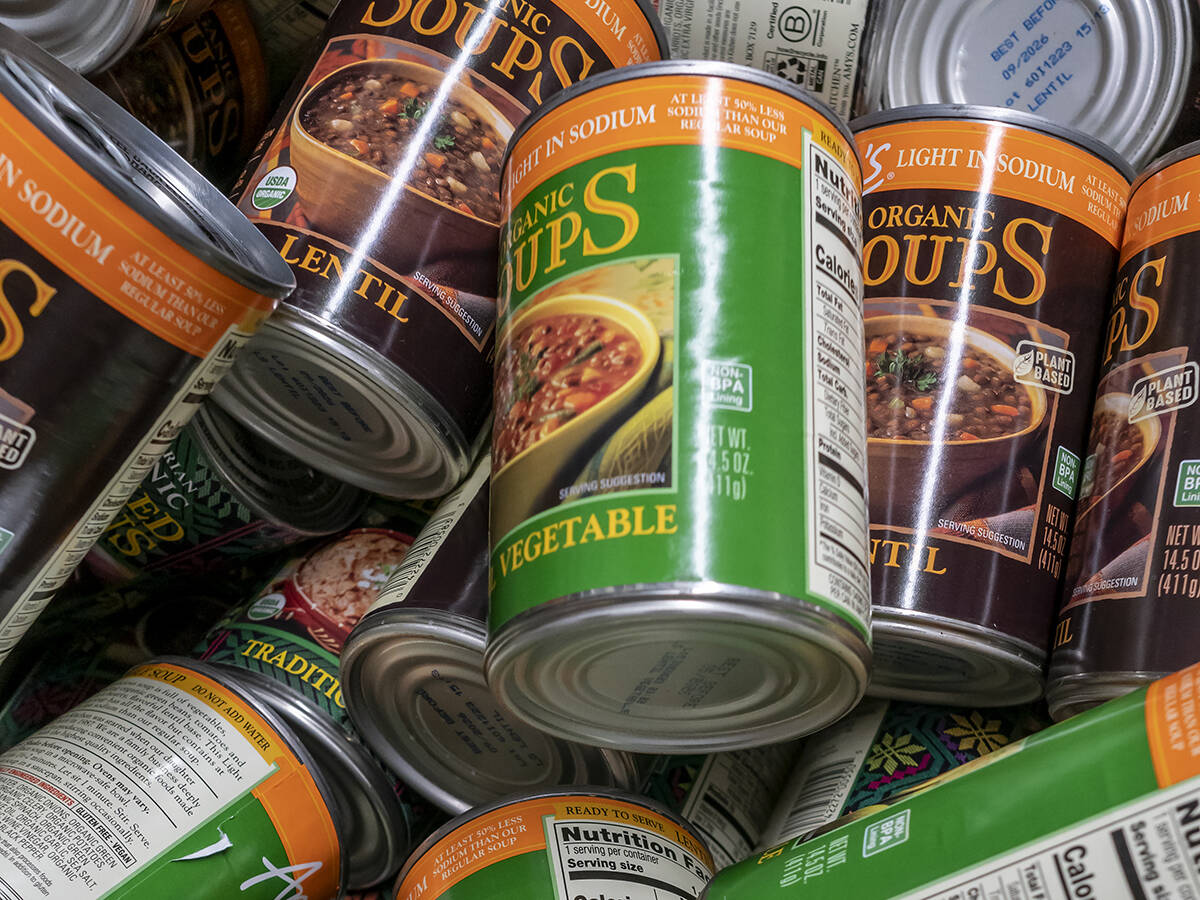It’s springtime, and many of us are into our new routines, which include running to the field, running to children’s sporting events, and in our spare time cooking for the family.
At our house we are also getting used to a new baby girl, which is quite a change for us. And yes, I am typing this column with her in my arms, since she does not want to sleep and she is too little to bribe. We have not had a baby in the house for four years, and I guess I got used to the “big kid” freedom that parents talk about.
Read Also

Sustainable food has ‘lost all meaning’: prof
That marketing strategy is deader than a doornail, says a University of Guelph professor who specializes in consumer preferences and perceptions of agriculture and food.
At any rate, we are having fun getting back into diaper changes, scheduling feeding around all of our events, and nighttime waking. I have again experienced the feeling of rocking a baby to sleep, and looking at the peaceful look on her face. It has only been a few weeks, but I can honestly say that she is fitting in well, and I can’t remember our life without her.
One of the biggest challenges is keeping everybody in the family fed. Here are some great-tasting and somewhat healthy recipes that are sure to satisfy. The recipes have worked at our house. I serve the salads with either a roasted chicken or beef, served cold. All the items can be made ahead of time.
Broccoli salad kids eat
10 slices diced bacon
1 large broccoli head, washed and cut into florets
1/2 red onion, chopped
1 cup fresh 250 mL
mushrooms, sliced
1 cup golden raisins 250 mL
2/3 cup sunflower 150 mL
seeds, salted
Dressing:
1 cup mayonnaise 250 mL
1/4 cup sugar 50 mL
1 tablespoon vinegar 15 mL
Mix the first six ingredients into a bowl. Mix the dressing and pour over the top of the broccoli mixture. Stir and put in the refrigerator for several hours or overnight.
Makes 12 cups (three L).
Springtime potato salad
6 cups diced, peeled 1.5 L
and cooked potatoes
4 hard-cooked eggs, chopped
1/2 cup celery 125 mL
1/2 cup chopped 125 mL
sweet pickles
1/3 cup chopped onion 75 mL
1/3 cup chopped 75 mL
radishes
1/2 cup mayonnaise 125 mL
3 tablespoons sugar 45 mL
1 tablespoon vinegar 15 mL
1 tablespoon milk 15 mL
11/2 teaspoons prepared 7 mL
mustard
1/2 teaspoon salt 2 mL
paprika to sprinkle
In a bowl, combine potatoes, eggs, celery, pickles, onion and radishes.
In another bowl, combine mayonnaise, sugar, vinegar, milk, mustard and salt; mix well. Pour over potato mixture; stir to coat. Cover and refrigerate. Sprinkle with paprika before serving, if desired.
Hearty beef soup
If it is a soup kind of day, such as cloudy, windy or cool, why not try this filling soup?
1 pound ground beef 500 g
1 medium onion, chopped
2 cups cubed potatoes 500 mL
1 cup chopped celery 250 mL
1 cup diced carrots 250 mL
1 cup dry lentils, 250 mL
rinsed
1/2 cup pearl barley 125 mL
8 cups water 2 L
2 teaspoons beef 10 mL
bouillon granules
1 teaspoon salt 5 mL
1/2 teaspoon lemon 2 mL
pepper seasoning
2 19 ounce (540 mL) cans
tomatoes
In a skillet, cook beef and onion until meat is no longer pink; drain. Transfer to a slow cooker. Layer with the potatoes, celery, carrots, lentils and barley. Combine the water, bouillon, salt and lemon pepper; pour over vegetables. Cover and cook on low for six hours or until the vegetables and barley are tender. Add the tomatoes; cook two hours longer.
Slow cooker safety
Slow cooker recipes are often comfort foods, like stews and the above soup recipe. But if used improperly, such cooking can cause food to develop enough bacteria to make eaters sick.
- Do not use a slow cooker for roasts or whole chickens. A slow-cooker heats food so slowly that bacteria could multiply.
- Always cut food into small pieces.
- Fill the cooker no less than half full and no more than two-thirds full. Place slower-to-cook vegetables at the bottom and around the sides of the pot. Then add meat, cover all the food with liquid such as sauce, broth or water and cover tightly.
- Schedule permitting, cook on high for one hour, then reduce to low for the remaining cooking time.
- Only remove the lid to stir or check to see if cooking is complete.
- If you are away during the cooking process when the power goes out, throw away the food even if it appears to be done. If at home, finish cooking immediately by some other means.
For more information on slow-cooker safety, or answers to other food safety concerns, call 800-892-8333 Monday through Friday from 9 a.m. to 5 p.m.
Information is also available on the website www.foodsafetyline.org.
Food preservation workshops
A matter of survival for our grandparents, home food preservation is enjoying a resurgence among today’s consumers. Don’t miss this opportunity to learn about the importance of proper food preservation techniques to ensure a safe, wholesome and quality product for the consumer.
Food preservation workshops teach the use of proper techniques and processes to ensure a high quality and safely preserved product. Workshops will be held at the following locations:
- Winnipeg, June 9, 8:30-11:30 a.m. University of Manitoba, Agriculture Building, Carolyn Sifton Auditorium, Dafoe St.
- Saskatoon, June 10, 8:30-11:30 a.m., College of Engineering, 57 Campus Drive, University of Saskatchewan.
- Calgary, June 11, 8:30-11:30 a.m., Southern Alberta Institute of Technology, Heart Building, C Wing, Room MC317, 1301 Ð 16 Ave.
- Vancouver, June 12, 8:30-11:30 a.m., Simon Fraser University Harbour Centre, Labatt Hall, Room 1700, 515 West Hastings St.
Workshops cost $40, including materials.
To register, phone the Food Safety Info Line at 800-892-8333, or e-mail Jane Carlyle at jane.carlyle@3web.net by May 30.
Healthy evergreens
If you take a drive around the countryside, you will notice there are brown patches on many of the evergreens. What causes this and how can we prevent it?
The warmth of spring can cause evergreens to brown. This browning affects the appearance and growth of the highly prized evergreens, and in severe cases, can kill them.
This is what Shelly Barkley, an information officer with Alberta Agriculture, says about the problem.
Browning can occur on a few branches at the top or sides, on one side or on the entire tree, and each evergreen will respond with different colours.
For example, cedar leaf scales will fade from green to light tan or reddish-brown, and the branches or branchlets of junipers will turn brown or orange. The needles of spruce and pine turn brown, although Colorado blue spruce can turn a purplish-brown.
Winter drying of needles occurs in warm winters because moisture is continuously lost through the needles and cannot be replaced because the roots are in an inactive state. Winds, whether warm or cold, will suck moisture from needles. Sometimes the snow cover line may be noticeable, since the snow offers protection from drying.
On warm, sunny winter days, radiation from the sun or reflection from snow and light-coloured buildings can raise leaf temperatures 20 C higher than the air temperature, which will exhaust the moisture in the stems and branches.
“Careful pruning is needed to restore the form of the evergreen,” Barkley said.
“However, first make sure what is dead and what is going to grow. If the soil in the root zone is dry, give the plant a good soaking, as that will prevent further drying damage. Fertilize lightly, if at all.”
To prevent browning, keep evergreens well-watered during the spring and summer, but be careful not to drown them. Keep them pest free and water late in the fall to ensure they are pumped as full of water as possible.
Local garden centres can provide information. Also, information on yard, garden, turf, shrub and tree care is included in the Alberta Agriculture publication, Alberta Yards and Gardens: What to Grow.
This book contains information to help Albertans successfully grow ornamental trees and shrubs, small fruits and berries, flowers, vegetables, herbs and water plants. It costs $15 , plus GST. Call 800-292-5697 to order a copy. It may also be ordered on-line at www1.agric.gov.ab.ca/app08/pps/order/orderform.jsp.
Cookbook draw
Send your name and address to: TEAM Resources Cookbook Contest, Box 2500, Saskatoon, Sask. S7K 2C4.
Deadline for entries is June 13.
A draw will be made from all the entries received and an ATCO Blue Flame Kitchen Everyday Delicious cookbook will be sent to the winners.
Jodie Mirosovsky is a home economist from Rosetown, Sask., and one of four columnists comprising Team Resources. Send correspondence in care of this newspaper, Box 2500, Saskatoon, Sask., S7K 2C4 or contact them at team@producer.com.
















